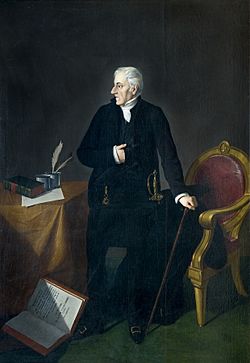Miguel Domínguez facts for kids
Quick facts for kids
Miguel Domínguez
|
|
|---|---|
 |
|
| Member of Supreme Executive Power | |
| In office April 1, 1823 – October 10, 1824 Serving with Guadalupe Victoria
Pedro Celestino Negrete José Mariano Michelena Nicolás Bravo and Vicente Guerrero |
|
| Preceded by | Constitutional Monarchy Agustín I |
| Succeeded by | Federal Republic Guadalupe Victoria |
| Personal details | |
| Born |
Miguel Ramón Sebastían Domínguez Alemán
January 14, 1756 Mexico City New Spain |
| Died | April 22, 1830 (aged 74) Mexico City Mexico |
| Nationality | |
| Spouse | Josefa Ortiz de Domínguez |
| Occupation | Lawyer Politician |
José Miguel Domínguez Alemán (born January 14, 1756, died April 22, 1830) was an important official in New Spain (which is now Mexico). He played a big role in Mexico's fight for independence from Spain.
After Mexico's first emperor, Agustín de Iturbide, stepped down, Domínguez was part of a group that governed the country. This group led Mexico until Guadalupe Victoria became the first president. His wife, Josefa Ortiz de Domínguez, was also a famous hero of Mexican independence.
Contents
Early Life and Career
Miguel Domínguez was a Criollo, meaning he was a Spaniard born in America. His parents, however, were from Spain. He studied law at the College of San Ildefonso and became a lawyer. In 1791, he met Josefa Ortiz and they got married that same year. She was 12 years younger than him.
Domínguez held many different jobs in the government of New Spain. The Viceroy, Félix Berenguer de Marquina, made him the corregidor (a kind of mayor or magistrate) of Querétaro. In 1808, he suggested that Querétaro and Mexico City should form a special council. This council would govern New Spain in the name of King Ferdinand VII, who had been removed from power by the French.
The Fight for Independence
In Querétaro, Domínguez and his wife were part of a secret group planning Mexico's independence. They held meetings disguised as a literary club at the home of a priest, José María Sánchez. The corregidor himself protected these meetings.
Other people involved included military officers like Ignacio Allende and Juan Aldama. They were in touch with Father Miguel Hidalgo in Dolores. The group planned to start their rebellion on December 1, 1810, but later changed the date to October 2.
The Conspiracy is Discovered
However, their plans were found out. On September 10, 1810, someone told the authorities about the conspiracy in Querétaro. The corregidor was ordered to arrest the plotters. He raided the home of Epigmenio González, one of the rebels, and found weapons. He had González arrested.
Knowing his wife was deeply involved, Domínguez locked her in an upstairs room. He then left to warn the local militia. But Josefa Ortiz managed to alert a fellow conspirator, Ignacio Pérez, who was in the house next door.
On September 15, 1810, Pérez rode to San Miguel, and then to Dolores, to deliver the warning. Early the next morning, September 16, 1810, Father Hidalgo gave the famous Grito de Dolores (Cry of Dolores). This event marked the beginning of the war for Mexican independence.
After the Uprising
Because of their involvement, both Domínguez and his wife were arrested. They were held in a convent in Querétaro. Three years later, in 1813, Josefa Ortiz was moved to a convent in Mexico City, where she remained a prisoner for several more years.
Domínguez was no longer a prisoner, but he lost his job. He moved to Mexico City to be closer to his wife and was allowed to visit her sometimes. Later, the Viceroy Juan Ruiz de Apodaca gave him a small pension for his past service.
After Independence
In 1823, after Emperor Iturbide's rule ended, Miguel Domínguez was part of a three-person group (a triumvirate) that governed Mexico. This group held executive power until Guadalupe Victoria became president under the Constitution of 1824.
From 1825 to 1827, Domínguez was named the president of Mexico's Supreme Court. In 1830, he also served as the President of the Chamber of Deputies, which is like the leader of one part of the Mexican parliament.
Miguel Domínguez passed away in Mexico City in 1830, at the age of 74. This was one year after his wife had died.
Images for kids
See also
 In Spanish: Miguel Domínguez para niños
In Spanish: Miguel Domínguez para niños


